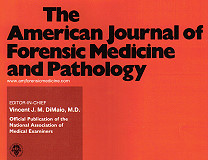

 |
 |
Restraint Asphyxia. A Letter to the Editor |

CITATION:
Patel F. Custody restraint asphyxia.
Am J Forensic Med Pathol (United States), Jun 2000, 21(2) p196-197.
A letter to the Editor Regarding: Chan TC, Vilke GM, Neuman T.
Reexamination of custody restraint position and positional asphyxia.
Am J Forensic Med Pathol 1998;19:201-5.
AUTHOR:
Patel, F. F.R.C. Path., D.M.J.
Greater London Forensic Medical Practice; London, England
CHAS' OPINION of Patel's gross misinterpretation of Chan et al's restraint "research" (such as his terrifically misinformed statements that "asphyxia in these circumstances may be a myth", and that "Dr. Reay ... appears to have revised some of the views held") will be reflected in her 2005 Paper:
Restraint Asphyxia Research Review
When that paper is posted, the above link will work.

To the Editor:
The review by Chan et al.(1), which gives fresh airing to the subject of restraint asphyxia in custodial deaths, is another excellent example of a thought-provoking article like the one on short-distance falls by the late Dr. Root(2), which sidelines political correctness and exposes some of the myths in forensic practice. A request has been made for well-balanced and critically reviewed articles confronting well-known forensic controversies so that modern concepts may be introduced(3).
The so-called positional asphyxia used synonymously with postural asphyxia in these circumstances may be a myth and should be treated with caution. Further, the term has been misappropriated for mechanical asphyxia, in which restriction in the prone position causes lethal respiratory embarrassment. A better term for these deaths is restraint asphyxia, which would take into account the deliberate action of a third party and absence of any significant cardiac or other cause of death. Acceptable definitions near to those issued in the bulletin of the National Law Enforcement Technology Center (United States) must be found(4). Meanwhile, it is proposed as a cause of death, "custodial unexplained sudden type of death (CUSTOD) syndrome" for these enigmatic fatalities and which may be convenient for all concerned.
I am concerned with deaths in custody after aggressive and violently resisted legal arrests or agitation and fierce struggle during physical restraint in acute excited states. There may be additional psychiatric illness and consumption of illicit substances or neuroleptic stimulants. The "hog tied" position is an American issue, and few of the anecdotal case reports involved confounding factors(5,6).
In a case in which I was involved, certain articles including that by Reay et al.(5) were presented by those representing the family in the coroner's court and successfully convinced the inquest jury that the death was due to "positional" asphyxia, even though there was absolutely no similarity with the cases reported in the literature. It is impossible to prove at necropsy a hypothesis that in a frightful situation the sudden epinephrine (adrenaline) rush with associated biochemical disturbance sensitizes the heart and causes fatal cardiac arrhythmia. Paradoxically, an emergency revival of these patients includes administration of more epinephrine. It remains unclear whether asphyxiation is indeed the mode of death in "hog tied" restraint.
The deceased was a young, stocky Afro-Caribbean man who was arrested after a brief police chase following a burglary. There were no significant marks of violence or forceful restraint despite allegations of police brutality, and the drug screen results were negative. I attributed his death to hypertensive heart disease (HHD), which may have been aggravated by emotional stress or physical exertion. The heart showed concentric left ventricular hypertrophy and weighed 400 g on a crude scale (since replaced) in the mortuary, but other medical experts dismissed HHD on the basis that the heart weight was not significant enough and that cardiac rigor could have been mistaken for the hypertrophy. The last recorded blood pressure in the past was 140/90 mm Hg.
Chan et al.(1) make it clear that although death may occur in restraint position, the role of prone position and asphyxiation is not clear, and perhaps unrelated factors may be more important determinants of the sudden death. Their conclusion was that "hog tied" restraint does not itself cause asphyxiation, but other factors are responsible for sudden death(1), which concurs with my opinions expressed at the earlier inquest. They found flawed methodology and physiological contradiction that invalidated the work of Reay et al., upon which inaccurate theory of positional asphyxia was based. There were no clear data to support many of the conclusions in the literature on "hog tied" position and restraint asphyxia(1). The Home Office Policy Advisory Board for Forensic Pathology (England and Wales) circulated relevant information and notified that Dr. Reay, who was their main speaker at a seminar on restraint asphyxia in 1997, appears to have revised some of the views held (Personal communication, 1998).
It is interesting to note that although law enforcement officers make so many arrests daily in a stressful environment and many of the subjects who may be in an acute excited state are placed in the prone position, there is no epidemic of restraint asphyxia. Further, on the sports track it is common to see exhausted athletes rest in the prone position to aid recovery, without seemingly restricting respiration, and in the wrestling ring obese heavyweights squat on catecholaminized opponents who are also laid on the mat in the hog tied posture without any apparent cardiopulmonary ill effect.
Dr. F. Patel, F.R.C. Path., D.M.J.
Greater London Forensic Medical Practice; London, England
REFERENCES
(1) Chan TC, Vilke GM, Neuman T. Reexamination of custody restraint position and positional asphyxia. Am J Forensic Med Pathol 1998;19:201-5.
(2) Root I. Head injuries from short distance falls. Am J Forensic Med Pathol 1992;13:85-87.
(3). Patel F. Head injuries from short distance falls. Am J Forensic Med Pathol 1993;14:171.
(4). Department of Justice. Positional asphyxia-sudden death. Rockville, MD: National Institute of Justice, 1995.
(5) Reay DT, Fligner CL, Stilwell AD, Arnold J. Positional asphyxia during law enforcement transport. Am J Forensic Med Pathol 1992;13:90-97.
(6) O'Halloran RL, Lewman LV. Restraint asphyxia in excited delirium. Am J Forensic Med Pathol 1993;14:289-295.


 Email Charly at: c-d-miller@neb.rr.com
Email Charly at: c-d-miller@neb.rr.com